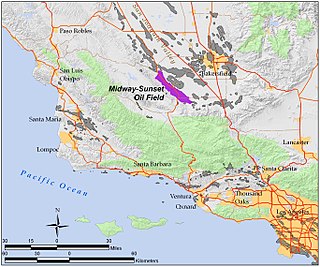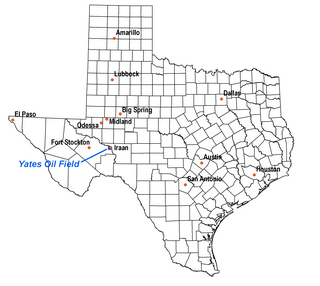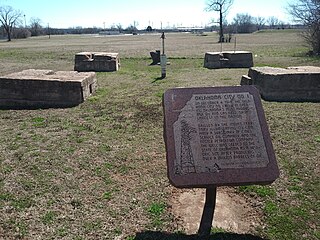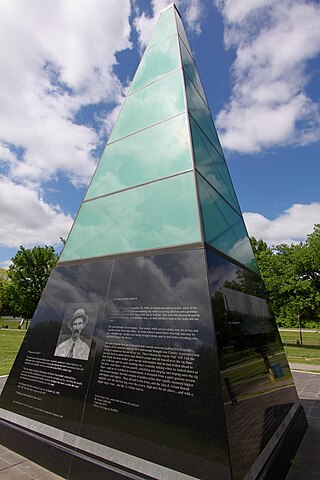Related Research Articles

The history of the petroleum industry in the United States goes back to the early 19th century, although the indigenous peoples, like many ancient societies, have used petroleum seeps since prehistoric times; where found, these seeps signaled the growth of the industry from the earliest discoveries to the more recent.

Spindletop is an oil field located in the southern portion of Beaumont, Texas, in the United States. The Spindletop dome was derived from the Louann Salt evaporite layer of the Jurassic geologic period. On January 10, 1901, a well at Spindletop struck oil. The Spindletop gusher blew for 9 days at a rate estimated at 100,000 barrels (16,000 m3) of oil per day. Gulf Oil and Texaco, now part of Chevron Corporation, were formed to develop production at Spindletop. The Spindletop discovery led the United States into the oil age. Prior to Spindletop, oil was primarily used for lighting and as a lubricant. Because of the quantity of oil discovered, burning petroleum as a fuel for mass consumption suddenly became economically feasible.

Glenpool is a city in Tulsa County, Oklahoma, United States. It is part of the Tulsa Metropolitan Statistical Area (TMSA). As of 2020, the population was 14,040, which represented an increase of 29.9% since the 2010 census, which reported the total population as 10,808.

The Mid-continent oil field is a broad area containing hundreds of oil fields in Arkansas, Kansas, Louisiana, New Mexico, Oklahoma and Texas. The area, which consists of various geological strata and diverse trap types, was discovered and exploited during the first half of the 20th century. Most of the crude oil found in the onshore Mid-continent oil field is considered to be of the mixed base or intermediate type.

A blowout is the uncontrolled release of crude oil and/or natural gas from an oil well or gas well after pressure control systems have failed. Modern wells have blowout preventers intended to prevent such an occurrence. An accidental spark during a blowout can lead to a catastrophic oil or gas fire.

The Lakeview Gusher was an eruption of hydrocarbons from a pressurized oil well in the Midway-Sunset Oil Field in Kern County, California, in 1910. It created the largest accidental oil spill in history, lasting 18 months and releasing an estimated 9 million barrels of crude oil.
The Canadian petroleum industry arose in parallel with that of the United States. Because of Canada's unique geography, geology, resources and patterns of settlement, however, it developed in different ways. The evolution of the petroleum sector has been a key factor in the history of Canada, and helps illustrate how the country became quite distinct from her neighbour to the south.

The Midway-Sunset Oil Field is a large oil field in Kern County, San Joaquin Valley, California in the United States. It is the largest known oilfield in California and the third largest in the United States.

The Lost Hills Oil Field is a large oil field in the Lost Hills Range, north of the town of Lost Hills in western Kern County, California, in the United States.
Thomas Baker Slick Sr. was born in Shippenville, Clarion County, Pennsylvania to Johnson M. and Mary A. Baker Slick. He became notable in 1912 for discovering Oklahoma's then-largest oil field, the Cushing Oil Field.

The Yates Oil Field is a giant oil field in the Permian Basin of west Texas. Primarily in extreme southeastern Pecos County, it also stretches under the Pecos River and partially into Crockett County. Iraan, on the Pecos River and directly adjacent to the field, is the nearest town. The field has produced more than one billion barrels of oil, making it one of the largest in the United States, and in 1998 it remains productive, though at a diminished rate. Since fracking has exploded in the Permian Basin, the Yates field has seen very heavy activity in the past three years. Estimated recoverable reserves are still approximately one billion barrels, which represents approximately 50% of the original oil in place (OOIP).

The Oklahoma City Oil Field is one of the world's giant petroleum fields and is located in Oklahoma City, Oklahoma in the United States of America. The field was opened just south of the city limits on December 4, 1928, and first entered Oklahoma City limits on May 27, 1930.

The Spindletop-Gladys City Boomtown Museum is located in Beaumont, Texas, to commemorate the discovery of oil at the Spindletop Hill salt dome in Beaumont on Jan. 10, 1901. The discovery sparked an oil boom in Texas that continues today. Along with a gift shop with commemorative gifts, the museum features historical, period reenactments by area performers. A replica of the wooden oil derricks that once dotted the landscape of Spindletop Hill in the early 1900s has been erected near the museum. For special occasions and anniversaries, the museum staff “blows the gusher” with a plume of water and provides a historical narrative and sound effects to simulate the discovery of oil at Spindletop.
The Wheeler No. 1 Oil Well was the first well drilled in the Drumright-Cushing Oil Field of northeast Oklahoma, near Drumright. The success of the well, drilled in 1912 by Thomas Baker Slick, Sr., led to the development of the Cushing field and gave impetus to the early development of Oklahoma oilfields. The Drumright-Cushing field would go on to produce 310,000 barrels of oil a day at its peak in May 1917. The well made Slick's name as "King of the Wildcatters".

The Oklahoma City Discovery Well was the first successful oil well to be drilled in Oklahoma City, Oklahoma. The December 4, 1928 discovery opened the Oklahoma City Oil Field to extensive exploitation, creating an oil boom that sustained the area through the Great Depression. Because much of the oil was under the existing city, the Oklahoma City field pioneered the use of directional drilling to allow lateral displacement of well bores to reach deposits under developed areas.

Nellie Johnstone No. 1 was the first commercially productive oil well in Oklahoma. Completed on April 15, 1897, the well was drilled in the Bartlesville Sand near Bartlesville, opening an era of oil exploration and development in Oklahoma. It was abandoned as a well in 1964. The site was donated to the city of Bartlesville and is now a park, listed on the National Register of Historic Places, featuring a restored drilling rig.

The Washington oil field is an oil field and in Washington County, Pennsylvania. It also produced natural gas.

The California oil and gas industry has been a major industry for over a century. Oil production was a minor factor in the 19th century, with kerosene replacing whale oil and lubricants becoming essential to the machine age. Oil became a major California industry in the 20th century with the discovery on new fields around Los Angeles and the San Joaquin Valley, and the dramatic increase in demand for gasoline to fuel automobiles and trucks. In 1900 California pumped 4 million barrels (640,000 m3), nearly 5% of the national supply. Then came a series of major discoveries, and the state pumped 100 million bbl (16 million m3) in 1914, or 38% of the national supply. In 2012 California produced 197 million bbl (31 million m3) of crude oil, out of the total 2,375 million bbl (378 million m3) of oil produced in the U.S, representing 8.3% of national production. California drilling operations and oil production are concentrated primarily in Kern County, San Joaquin Valley and the Los Angeles basin.

The Alamitos oil well #1 or Alamitos #1 is the site of a famous oil well in Signal Hill, California, the start of the Long Beach oilfield. The spot is also known as Porcupine Hill. The Alamitos well #1 was designated a California Historic Landmark on May 1, 1957. The Signal Hill oil discovered in 1921 became the black gold of Southern California. Alamitos #1 started drilling on March 23, 1921. The leader of the drilling was O.P. "Happy" Yowells. On June 23 at 9:30 a.m. the drill, at about 2,765 feet down, hit oil that was trapped under ground. The trapped oil was pressurized by natural gas. The pressure pushed the blowout oil 114 feet into the air, when the drill hit the oil. The drilling rig collapsed in the blowout. A new clean well was drilled nearby and started production on June 25, 1921. Alamitos oil well #1 put out 600 barrels a day and 700,000 barrels before running out.

The discovery of the Glenn Pool Oil Reserve in 1905 brought the first major oil pipelines into Oklahoma, and instigated the first large scale oil boom in the state. Located near what was—at the time—the small town of Tulsa, Oklahoma, the resultant establishment of the oil fields in the area contributed greatly to the early growth and success of the city, as Tulsa became the petroleum and transportation center of the state, and the world.
References
- 1 2 3 "World Famous "Wild Mary Sudik"". American Oil & Gas Historical Society. Retrieved 2 May 2013.
- 1 2 3 "Wild Mary Sudik". Encyclopedia of Oklahoma History and Culture. Oklahoma Historical Society. Retrieved 2 May 2013.
- 1 2 "Wild Mary Sudik". Oklahoma Department of Libraries. Retrieved 2 May 2013.
- ↑ Mary Sudik No. 1 completion report - Publisher: Oklahoma Corporation Commission
- 1 2 3 4 Dean, Michael (March 29, 2010). "Wild Mary Sudik Revisited". Oklahoma Memories. Oklahoma Historical Society. Retrieved 3 May 2013.
- ↑ Knowles, Ruth Sheldon (1980). The Greatest Gamblers: The Epic of American Oil Exploration. University of Oklahoma Press. p. 239. ISBN 978-0806116549.
- ↑ Vandewater, Bob (April 24, 1994). "With Mighty Roar, "Wild Mary Sudik" Spewed Oil for Miles". The Oklahoman. Retrieved 2 May 2013.
- ↑ "Wild well caused days of trouble". Norman Transcript. April 2, 2006. Retrieved 3 May 2013.
- 1 2 3 "Mary Sudik". Daily Oklahoman. July 17, 1942. Retrieved 3 May 2013.
- ↑ Daily Oklahoman, June 30, 1940.
- ↑ Daily Oklahoman, December 13, 1945.
- ↑ Mary Sudik No. 1 plugging report - Publisher: Oklahoma Corporation Commission